This traditional Carbonara recipe tastes straight out of a restaurant but can be whipped up with only 5 ingredients in less than 30 minutes!
Pasta Carbonara is the indulgently creamy spaghetti of your dreams draped in a velvety cheese and egg sauce punctuated by shards of crispy guanciale, pancetta or bacon. It’s the no-food-in-the-house minimalistic dinner everyone will be begging for made with just eggs, noodles, cheese, and pork. This surprisingly easy Carbonara recipe comes together in minutes as the Pecorino Romano and beaten eggs are cooked into gloriously creamy existence simply by tossing with the hot pasta and a little fat from the pork. Finish your Spaghetti Carbonara off with a showering of freshly ground black pepper for silky, salty, savory, crispy, cheesy, egg-slick decadence in every bite. Serve this this foolproof recipe with garlic bread and Caesar salad for an easy dinner any night of the week or for special occasions!
We love quick cooking pasta dishes around here for an easy weeknight dinner win. Don’t miss some of our favorites: Fettuccine Alfredo, Cacio e Pepe, Bacon Spaghetti, Homemade Mac and Cheese, Weeknight Spaghetti Bolognese and Blackened Chicken Alfredo.
pin this recipe to save for later
how to make Carbonara Recipe Video
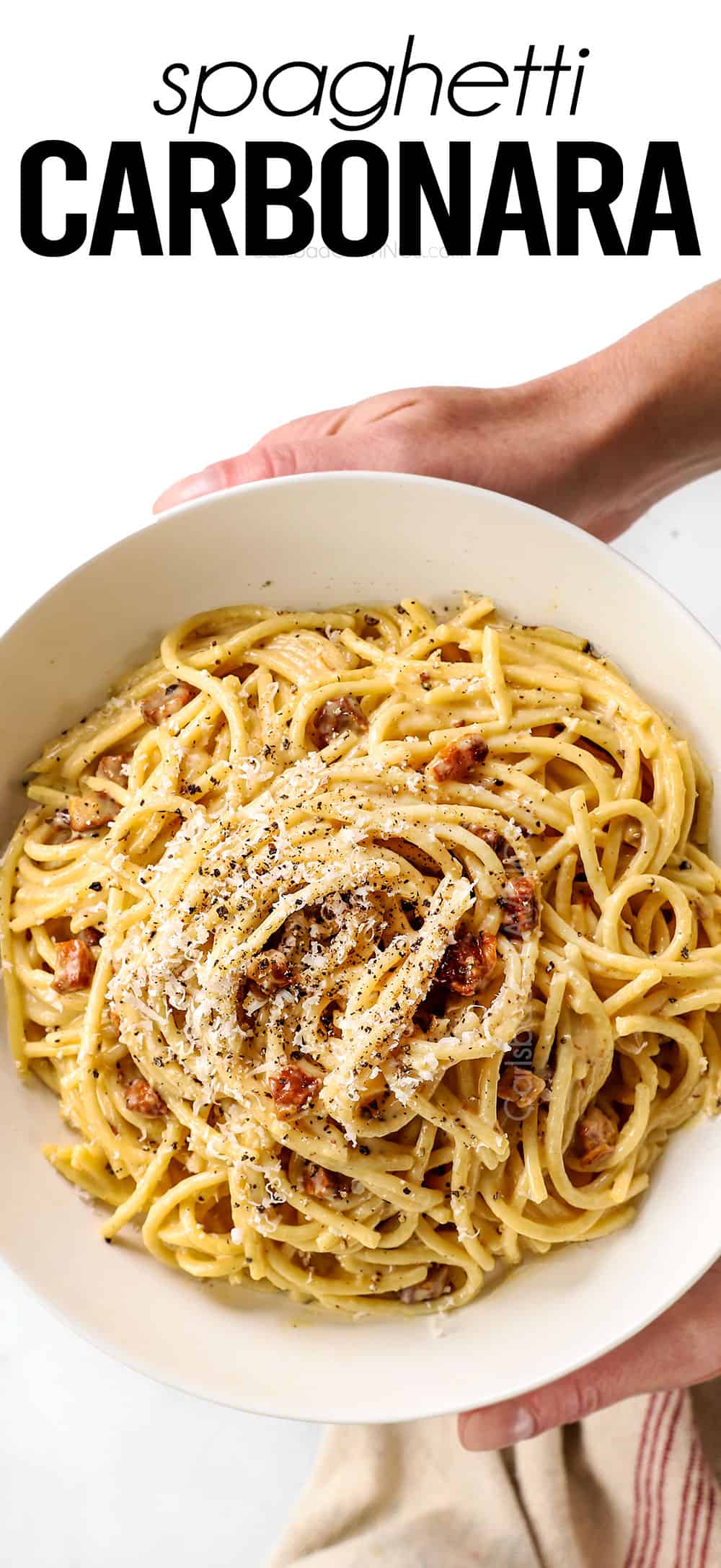
WHAT IS PASTA CARBONARA?
If you’re in the mood for some out-of-this-world rich and creamy carbs, Pasta Carbonara is calling your name. Carbonara is made with pasta, typically spaghetti, swaddled in a simple, wonderfully silky egg-Pecorino Romano cheese sauce punctuated with freshly ground pepper and pieces of savory, salty, crispy guanciale (a type of bacon). It is one of Rome’s four classic pastas along with cacio e pepe, amatriciana, and gricia.
Authentic Carbonara is distinguished by its humble ingredients and unique creamless cooking technique. The magic of Pasta Carbonara is the amazingly velvety sauce without an assist from butter or heavy cream. In fact, adding cream to the Carbonara Sauce, a shortcut sometimes used by Americans, is a huge no-no and detracts from the authenticity of this melty traditional Italian comfort food.
Instead, the glossy, gloriously creamy sauce is made from a simple emulsification of starchy pasta water, cheese, eggs and pork grease. The spaghetti is boiled in less water than usual which, in turn, concentrates the starches. The starches expand and burst, thickening and binding up the surrounding liquid, resulting in the luxuriously, rich, thick sauce. The Carbonara Sauce has all the perks and tastes of a cream-based sauce, but without the cream and heavy feeling you get afterwards!
Traditional Carbonara recipes also do not add garlic, parsley, onion, Parmigiano, pancetta or bacon. Spaghetti Carbonara is the epitome of less is more – simple ingredients combining to create something exponentially more delicious than the sum of their parts. Of course, this is YOUR Carbonara recipe, and I always advocate for making recipes your own, as long as you understand the traditional character and origins ;).
WHERE DOES CARBONARA COME FROM?
Pasta Carbonara originated in Rome in the Lazio region, although there are a few different speculations of its exact beginnings:
- Many believe Carbonara is the result of an American’s soldier’s rations and a Roman cook’s imagination in a Roman tavern called Vicolo della Scrofa in 1944. The story goes that the poor WWII soldier added his ration K, composed of powdered eggs, bacon and liquid cream to his pasta dish. The cook took note of the unique combination and soon whipped up his own version that spread across the region like wildfire.
- Others believe Pasta Carbonara is named after the carbonai, or charcoal burners, because it was a favorite of these workers who spent months deep in the Apennines and had to rely on transportable ingredients that could be prepared over a fire. Also, the word carbone means “charcoal” and could refer to the dish’s flecks of black pepper.
- The earliest evidence of Carbonara, however, is in 1839 in Ippolito Cavalcanti’s Neapolitan cookbook. The book’s Pasta Cacio e Uova, has nearly identical ingredients.
No matter the true origin of Pasta Carbonara, we all are beneficiaries of this uniquely simple, flavorful dish!
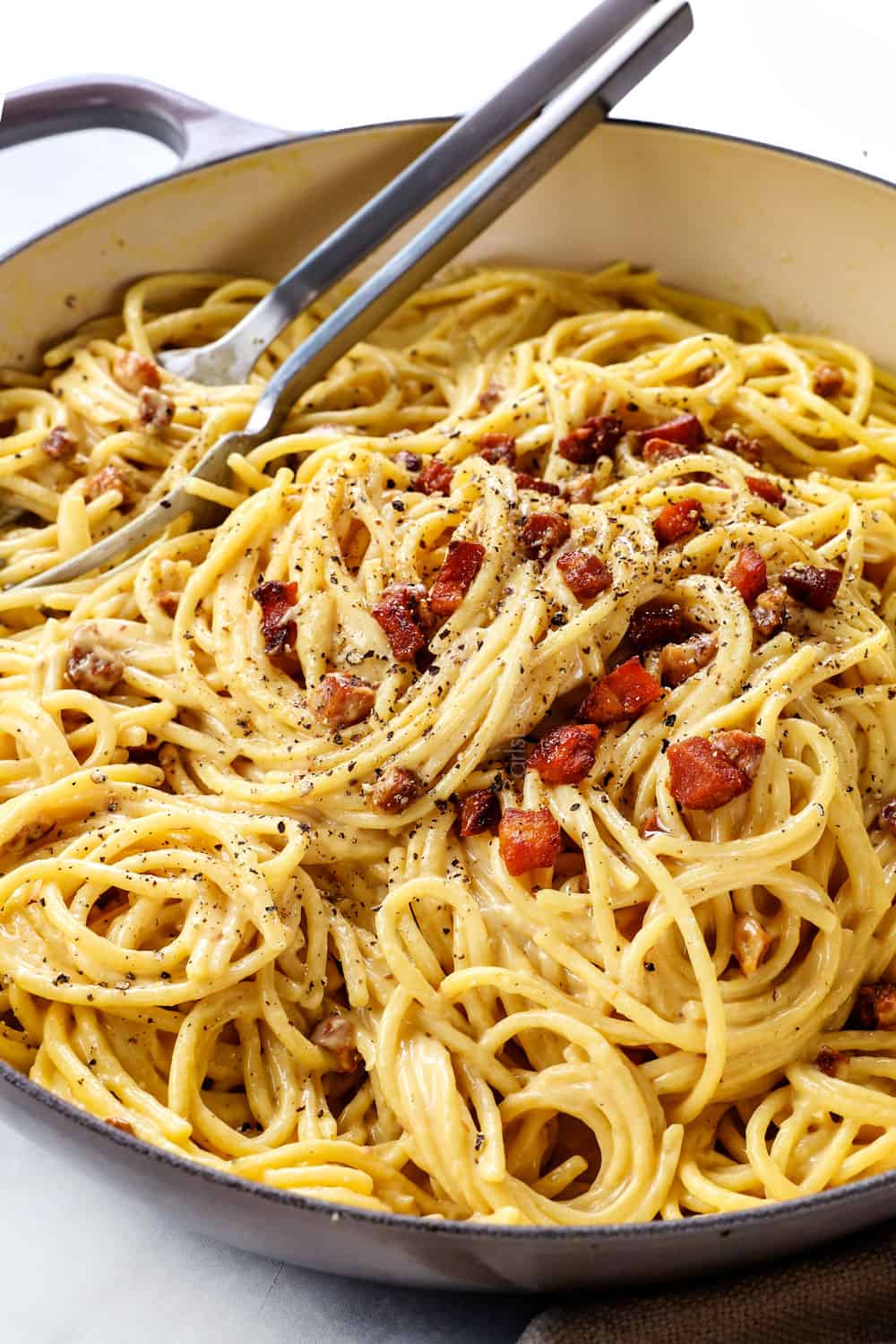
why this best carbonara RECIPE works:
This Carbonara recipe comes to you just in time for Valentine’s Day because it’s a complete show stopper that also happens to be incredibly simple to make.
While the cooking method is pretty straight forward – make a raw sauce with eggs and cheese, cook the pork, cook the pasta, then toss until creamy just from the heat of the drained pasta, Spaghetti Carbonara has a reputation for being temperamental. As such, there are many different approaches to tackle the same issues of scrambling eggs, thin sauce, soggy pork, bland pasta, etc.
But don’t worry, I’ve eaten my way through every technique to bring you a foolproof recipe that actually works every single time. Here’s what set’s this Carbonara recipe apart:
It starts with starchy pasta water
The spaghetti is cooked in a minimal amount of water and the reserved pasta water is only removed at the very end of cooking for maximum starchiness. This results is water that beautifully emulsifies with the eggs and cheese to create a richer, never-thin sauce.
It uses the correct cheese
Carbonara demands the best cheese because it’s an integral part of the distinctively creamy texture and flavor. Many Carbonara recipes call for Pecorino Romano OR Parmesan but traditional Carbonara is always made with Pecorino Romano because it is three times more flavorful! Pecorino also melts more easily than Parmesan.
It uses the correct egg to egg yolk ratio
The eggs are whisked with cheese, then tossed with the hot pasta to create the thick, creamy sauce. In order for the sauce to be rich and not sad and watery, it needs the correct ratio of double the number of egg yolks to whole eggs. Using too many whole eggs will create a thin sauce; using too many egg yolks will create a stubborn paste that’s difficult to loosen and toss through the pasta. The perfect ratio, however, creates the rich, silky smooth Carbonara Sauce.
It combines the best of traditional technique with foolproof technique
Most traditional Carbonara recipes cook the pork in a skillet, add the pasta to the drippings and then crack the eggs and add the cheese directly to the pasta. This method can easily create a scrambled, uneven sauce.
This Carbonara recipe embraces tossing the pasta in the skillet with the pork drippings (which sadly many other recipes skip), but the eggs are whisked with the cheese and some starchy pasta water off heat, then tossed with the spaghetti for a gloriously silky, cohesive, lump free sauce every time.
Additionally, the eggs and cheese are combined at the beginning of the recipe, so the pasta doesn’t have a chance to cool down – we need all the heat to cook the sauce! Make sure to check out all my tips for a perfect sauce that never scrambles the eggs below.
WHAT PASTA IS BEST FOR CARBONARA?
Use a long pasta: Carbonara requires a long, smooth pasta which allows you scrape up the bottom of the pan while cooking the sauce, almost like a mop, ensuring none of the sauce is left in contact with the pan’s hot surface for too long or else it can scramble.
Use a sturdy pasta: You want a pasta that can easily be enveloped in the sauce but is “toothy” enough, meaning it is hearty and thick enough to stand up against the velvety sauce. You don’t want a noodle like angel hair that will just melt away.
Here are the most popular pastas for Carbonara:
- Spaghetti: Is the most common pasta for Carbonara. It is easy to find, easy to work with and tastes superb.
- Bucatini: Looks like spaghetti but is slightly thicker and chewier with a hole running through the middle which is delightful because it gets filled with sauce.
- Spaghetti alla chitarra: Also known as maccheroni alla chitarra, is a variety of egg pasta typical of Abruzzo, Italy, with a square cross section about 2–3 mm thick.
- Ciriole: Is the thicker version of chitarra, approximately double the thickness of spaghetti.
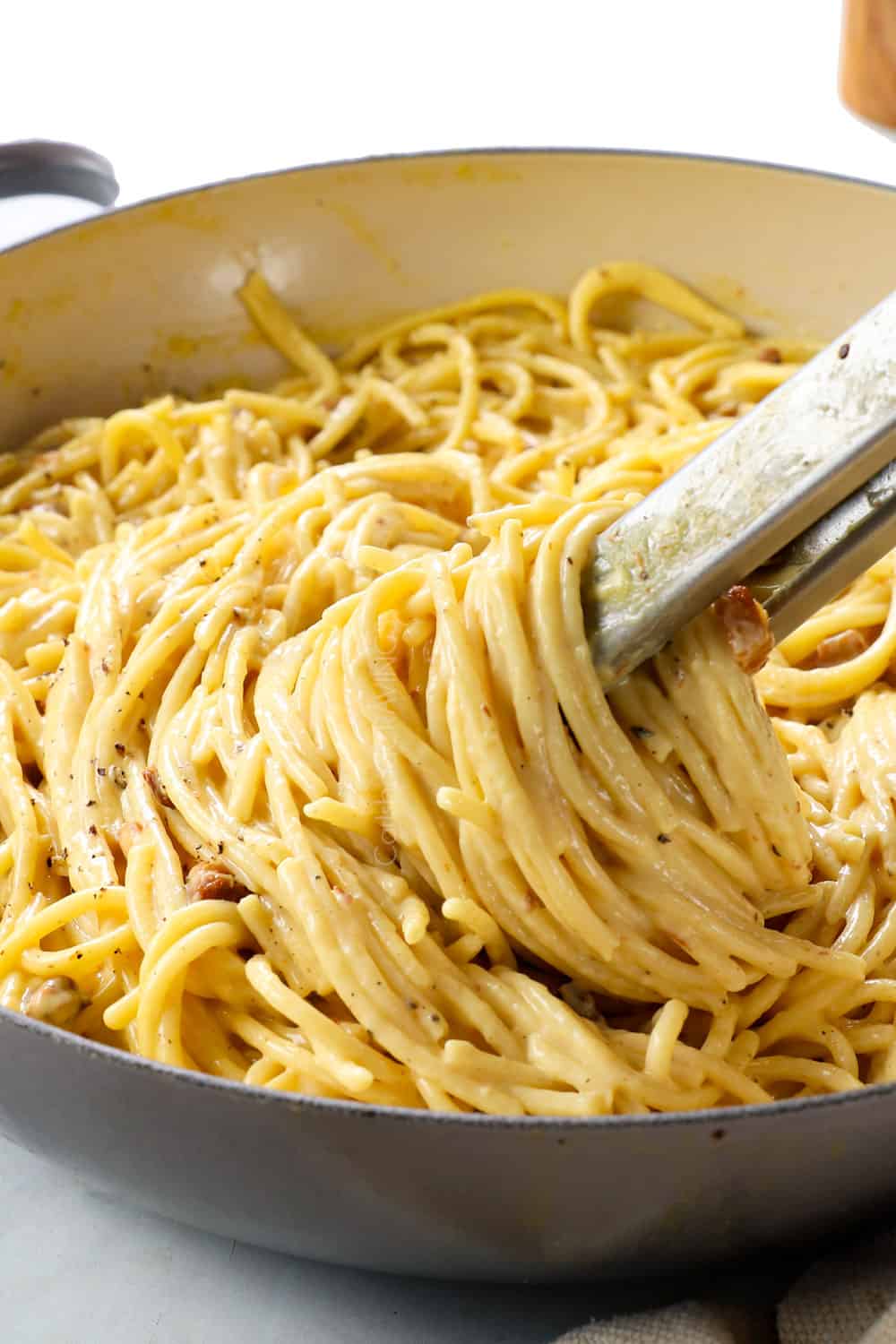
GUANCIALE VS BACON VS PANCETTA
Guanciale, an Italian cured pork cheek and a type of bacon, is the authentic meat of choice for Carbonara. This is the king of bacon because it’s especially fatty, salty, and flavorful, melting down perfectly to form delicious oils for the Carbonara Sauce. Additionally, the meat often is salted and cured with additional seasonings such as garlic, sage and rosemary, resulting in a sauce with tastier pronounced flavors.
Although guanciale is the first choice when it comes to making traditional Carbonara, if you can’t find it at your local grocery store, it’s perfectly fine to substitute it with thick-cut bacon or diced pancetta.
- Pancetta: will have a cleaner pork flavor than bacon because it is salt-cured, but it doesn’t stay as crispy and can become chewy quickly once combined with the pasta. If you go with pancetta, try to avoid the wafer-thin stuff. Instead, look for pancetta that you can cut into thick chunks yourself or sometimes you can find pancetta in containers in the meat or deli section that are cut into thick chunks for you.
- Bacon: American bacon is smoked so it will have a pleasantly sweet-smoky flavor and manages to retain its crispy texture. Make sure to use thick-cut bacon to mimic the texture of guanciale and so it stays crispier for longer.
CARBONARA SAUCE INGREDIENTS
If you have been following me for long, you know I will not hesitate to add an ingredient if I think it will improve a dish, but Pasta Carbonara is one case in which less, truly is more. This traditional recipe is made with just a few ingredients that magically transform into deep, rich, salty, satisfying splendor. That being said, it is important to use quality ingredients. For the Carbonara Sauce, you will need:
- Pecorino Romano cheese. Quality, aged Pecorino Romano is quintessential to authentic Carbonara – NOT Parmesan. Please do not use Parmesan as it is not nearly as flavorful (see below). Pecorino Romano can be found with the specialty cheeses at your grocery store. You will need 3 oz. which equals 1 ½ cups.
- Eggs: The ideal ratio of eggs is double the number of egg yolks to whole eggs. This creates a luxurious sauce with about the consistency of heavy cream with an eggy richness. You will need 4 egg yolks and 2 whole eggs for this recipe.
- Pepper: Use freshly cracked black pepper to instantly elevate your Spaghetti Carbonara. Unlike pre-ground pepper, freshly coarsely ground pepper has not been oxidized, or exposed to oxygen, which means it has a richer flavor and tastes worlds better than ground pepper. Its coarse texture also adds the peppery heat we love in Carbonara. I go for about 50 grinds of pepper, but you can use more or less to taste.
- Salt: Good old’ table salt is used to flavor the pasta water. Don’t skip or you’ll be skipping out on tons of free flavor and our only chance to flavor the pasta itself.
CAN I USE PARMESAN INSTEAD?
I’ve seen many Carbonara recipes calling for Pecorino Romano OR Parmesan, but this is not accurate. Authentic Carbonara is made with Pecorino Romano for a reason. It results in superior flavor and silkiness – AKA far superior pasta.
While both Pecorino Romano and Parmesan are aged, salty hard cheeses, Pecorino is WAY more flavorful. Pecorino Romano, made from sheep’s milk, is sharper, saltier, tangier, more pungent and assertive. Parmesan, made from cow’s milk, is a bit more neutral and milder overall. In fact, Cooks Illustrated suggests using one-third less Pecorino than Parmesan in recipe substitutions –that essentially means Pecorino Romano is 3x more flavorful!
All that being said, if you only have Parmesan on hand and want to make this Carbonara recipe – you may use Parmesan, but just be aware it will not taste as intoxicating as intended – next time splurge for the authentic cheese!
Can I use heavy cream?
I am all about making the best Carbonara recipe possible, even if it is not the purist. That being said, in this case, the purist is the best! Once you taste Carbonara made with just eggs, you’ll understand why heavy cream is completely unnecessary. It adds an overbearing richness and dilutes the delicate flavor of the eggs. After all, the dish is already rich enough with the eggs, egg yolks, fatty pork, pork grease and cheese. There simply isn’t any room for heavy cream!
Now, I can understand a case for heavy cream if the sauce didn’t have enough eggs or the pasta water wasn’t starchy enough, but in this recipe, the proportions are perfection.
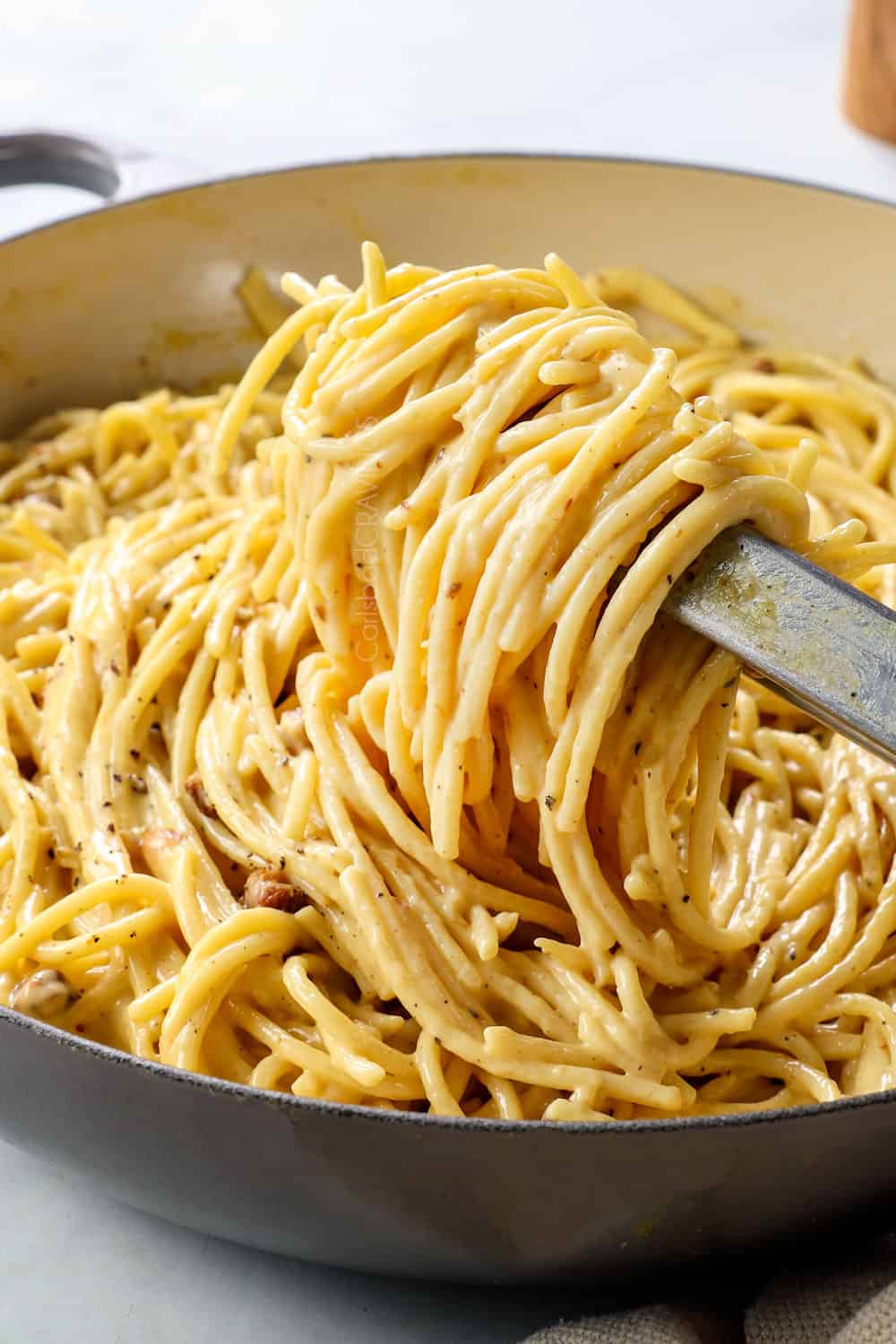
HOW TO MAKE CARBONARA
This Carbonara recipe requires a few steps, but each of them is very simple. Let’s take a closer look (full recipe with measurements in the recipe card at the bottom of the post):
- Step 1: Whisk together the egg mixture. It’s important to whisk together the eggs, egg yolks, grated cheese and pepper in a liquid measuring cup or bowl very first so it’s ready to be added to the just-drained pasta while it’s still hot. The residual heat is what cooks and thickens the sauce, so we don’t want to give it any time to cool down.
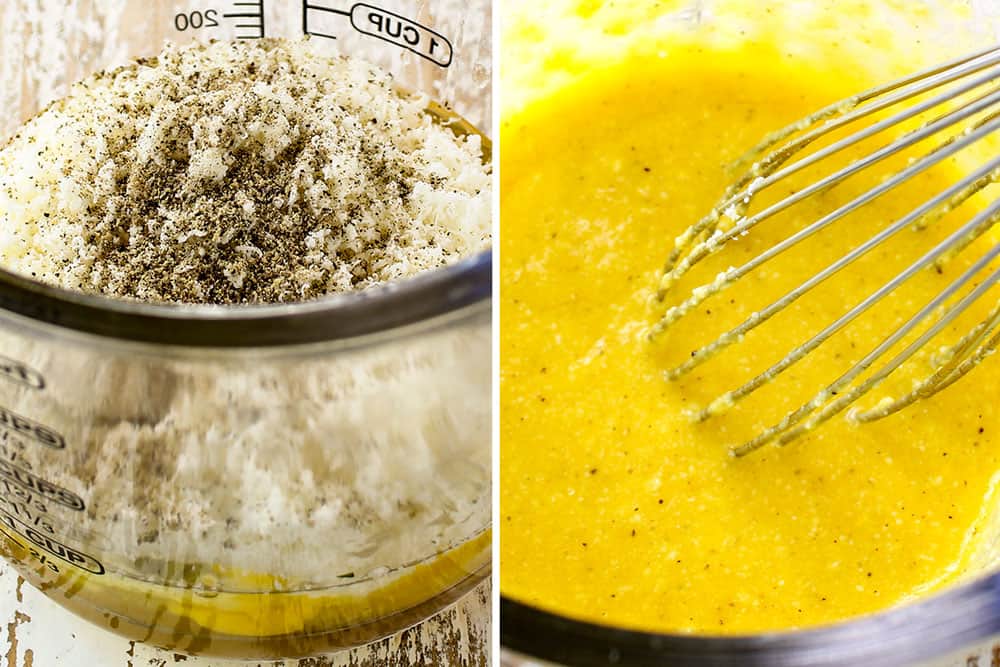
- Step 2: Cook the pork. You want a pan that’s large enough to eventually hold and toss all of the spaghetti and sauce in it. Once the pork is browned and crispy, remove it with a slotted spoon so you’re left with the gloriously flavorful drippings that will flavor the Spaghetti Carbonara. If there are more drippings than you feel comfortable with, you can drain some.
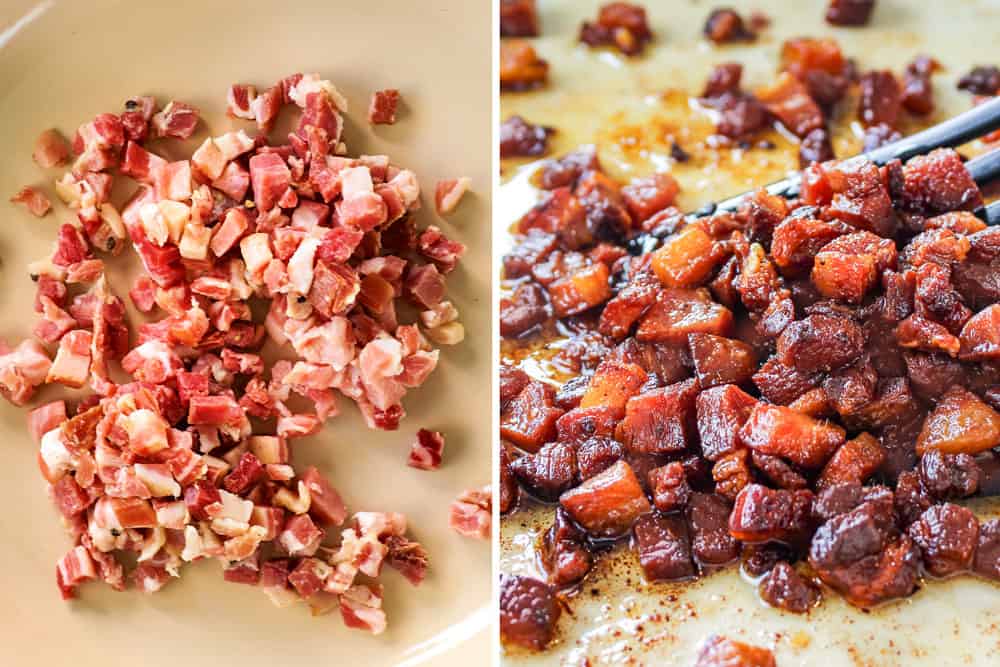
- Step 3: Cook the pasta. While the pork is cooking, get the pasta going. Use a wide pot to cook your spaghetti, like a large Dutch oven, so the shallow water can fully cover the pasta. We use less water so it can become extra starchy to reap its full emulsion powers. Cook the pasta one minute shy of al dente because it will continue to cook in the pork drippings. Transfer the spaghetti to the pork drippings using tongs and reserve all that starchy pasta water. You won’t use all of it, but it gives you more wiggle room so you have what you need.
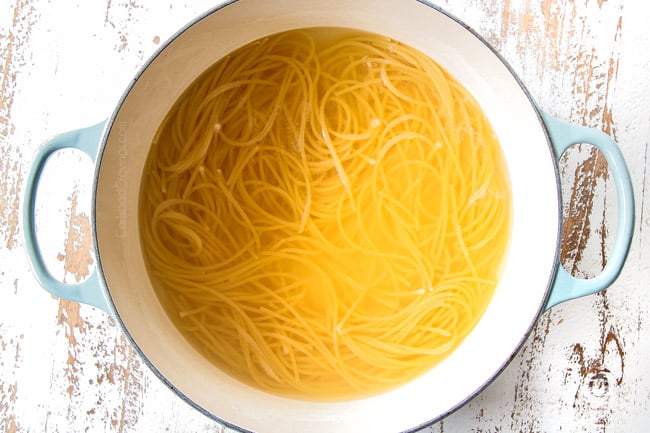
- Step 4: Combine hot water and egg mixture. Now that the pasta is cooked and we have the starchy pasta water, we’re ready to add some water to the egg mixture. While vigorously whisking the egg mixture with one hand, slowly drizzle 1 cup starchy hot water into the egg mixture a couple tablespoons at a time until incorporated. This tempers our egg mixture so it won’t immediately scramble when tossed with the hot pasta.
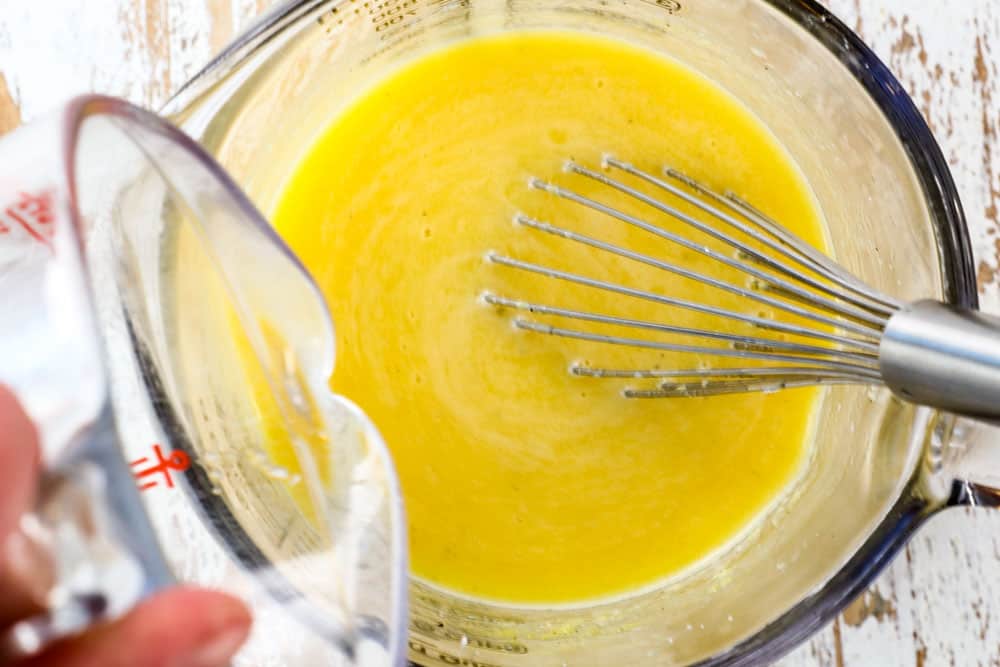
- Step 5: Toss the pasta Transfer the spaghetti to the sauté pan with the pork drippings and toss with ½ cup starchy pasta water until al dente, about 1 minute. This infuses the pasta with so much flavor!
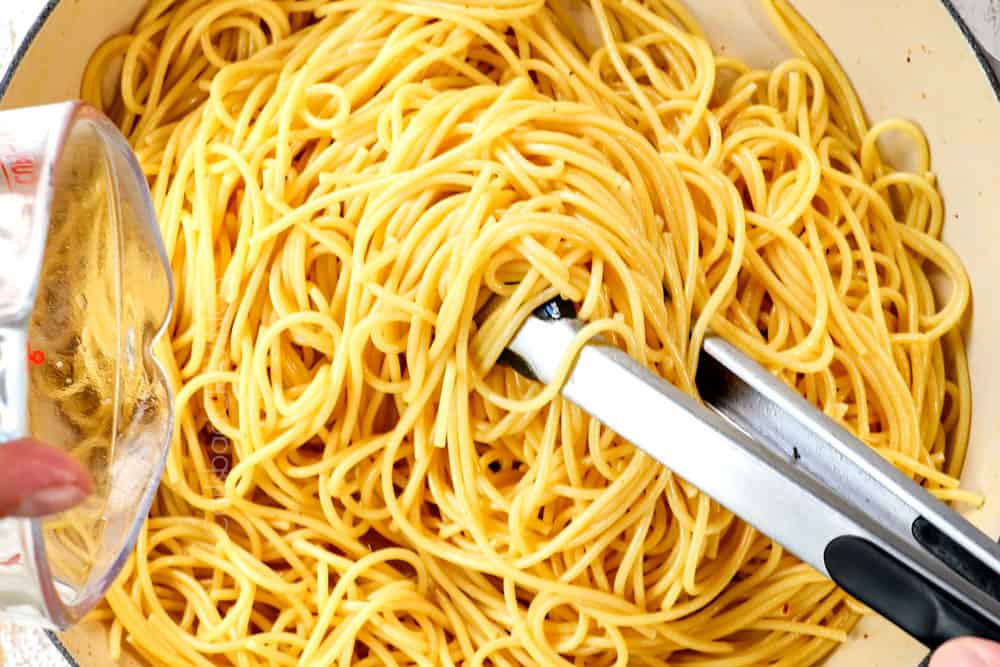
- Step 6: Add tempered egg mixture and pork. While continuously tossing the pasta, SLOWLY drizzle the egg mixture into the pasta. Continue tossing constantly until the cheese melts and the eggs thicken to form a glossy sauce. Add the guanciale, toss to combine and serve immediately.
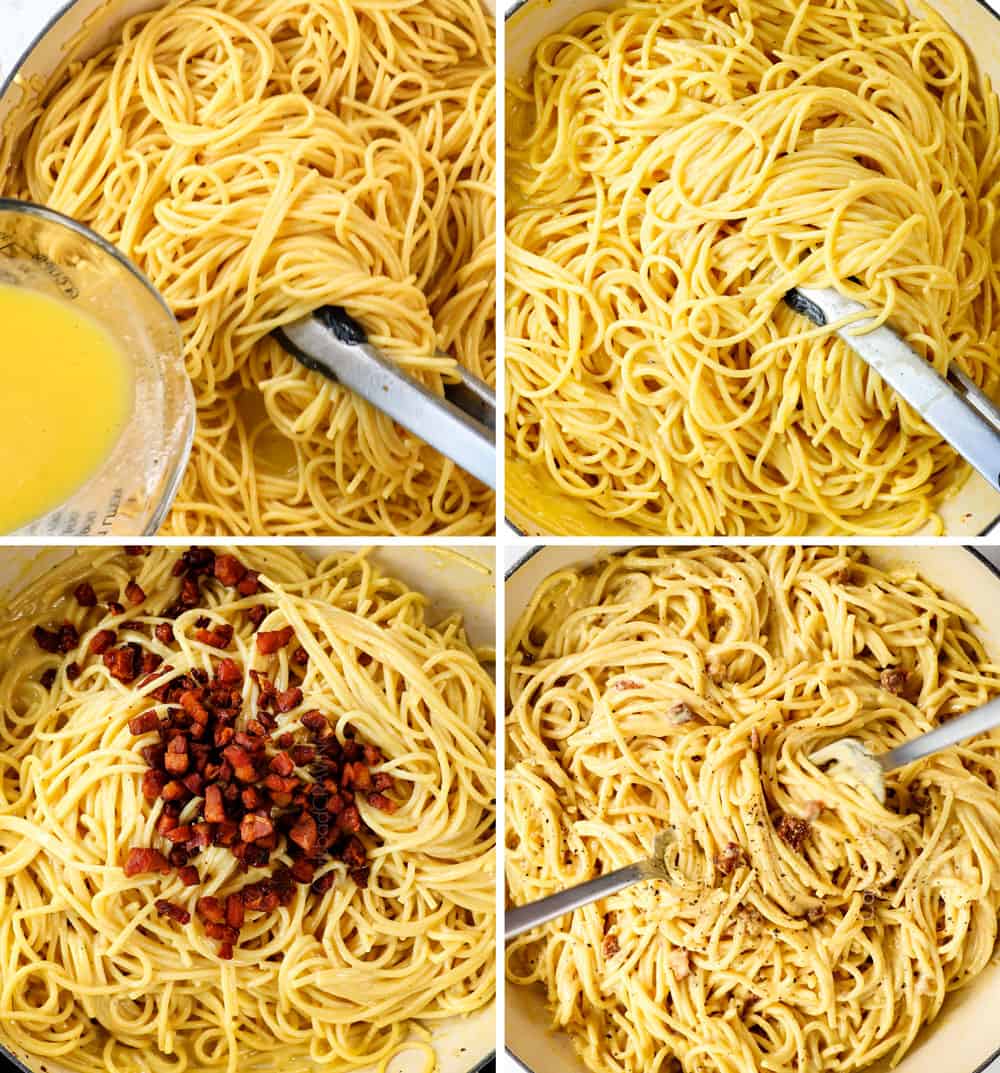
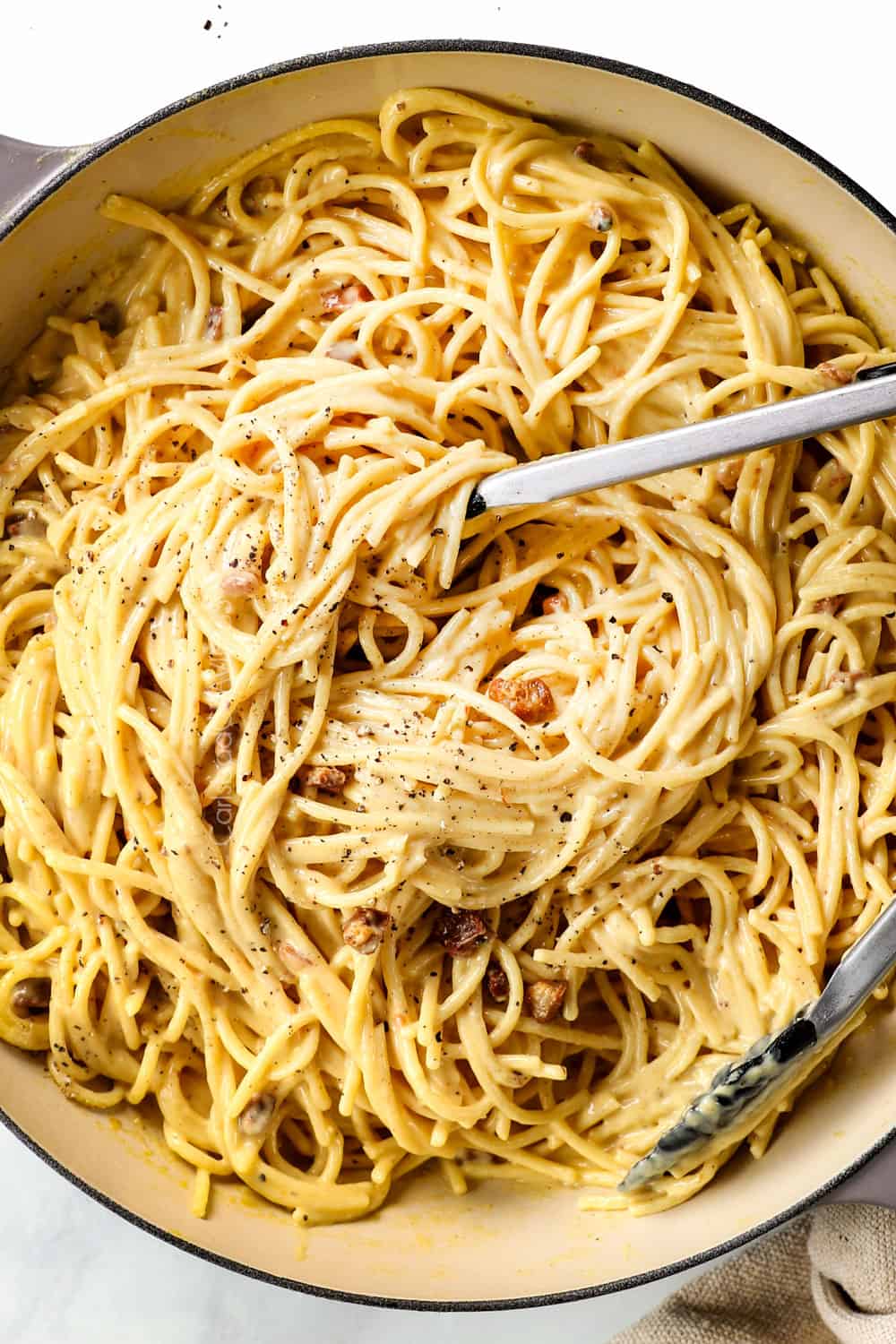
How do you stop Carbonara from scrambling?
A scrambled-egg sauce is the most common problem people encounter when cooking Carbonara. Thankfully, there are six easy techniques to prevent your sauce from scrambling:
- Temper the eggs: The eggs need to be tempered (slowly diluted) with some starchy pasta water so they don’t immediately scramble when combined with the hot pasta. When tempering the eggs, SLOWLY whisk some starchy water into the egg mixture and don’t stop WHISKING until all the water is incorporated.
- Add pasta water to the skillet before adding the eggs. Tossing the spaghetti with ½ cup of reserved starchy pasta water before adding the egg mixture helps to lubricate the skillet. If the pan is too dry, the eggs will immediately set and scramble when they touch the hot surface. To further prevent a sticky surface, I love using this braiser with an enameled finish.
- Use a long pasta: A long pasta, like spaghetti, is key so you can “mop” the sauce off of the bottom of the pan as it cooks to prevent it from catching and scrambling.
- Continuously toss the pasta with the egg mixture: This will reduce its contact with the hot pan so it will cook from the residual heat of the pasta instead of the direct heat of the pan.
- Don’t overcook the sauce: You’ll know the Carbonara Sauce is ready when it thickens, tightens, and clings to the spaghetti, leaving a clear trail as you stir. Don’t continue to cook after this point because the eggs can scramble.
- Transfer the Pasta Carbonara to a serving bowl – pronto! As soon as the sauce reaches a heavy cream consistency, immediately transfer it to a serving bowl, otherwise, it can easily overcook through the residual heat in the skillet.
more TIPS FOR MAKING pasta CARBONARA
Although Spaghetti Carbonara is incredibly simple, be sure not skip over the correct steps in order to create the silky-smooth pasta, When cooked correctly, this pasta dish is one for the books, especially if you love a savory pasta dish flavored from the melted oils of bacon fat and cheese. Here’s what to pay attention to:
FOR THE INGREDIENTS
- Use high quality ingredients at room temperature. High quality ingredients are essential in this dish, most importantly, Pecorino Romano. Use the best imported Pecorino Romano that you can afford. Make sure the cheese and eggs are at room temperature so they mix more easily.
- Grate the cheese yourself. Freshly-grated Pecorino Romano is a MUST in this Carbonara recipe. If you use pre-grated cheese, your sauce will by clumpy. Pre-packaged cheeses are coated with anti-clumping chemicals which inhibit them from melting beautifully. Freshly grated cheese is much more flavorful, creamier and melts more easily.
- Use finely grated cheese. Grate your cheese on the finest holes of your cheese grater, the small, prickly side of the box grater. We want to produce powdery Pecorino Romano that looks like what comes in the store-bought containers with the green lid. Cheese that’s grated on larger holes will clump because it takes the cheese longer to melt and the larger amount of surface area allows for more clinging potential.
FOR COOKING THE SPAGHETTI
- Don’t skip the salt. Salting the pasta water infuses the pasta and the water with flavor which translates to more flavorful Pasta Carbonara.
- Do NOT adjust the amount of water for cooking the spaghetti. The concentrated starchy pasta water is critical to the success of this recipe. Do NOT increase the amount of water or it will become less starchy.
- Stir spaghetti frequently while it cooks. Because we are cooking the pasta in less water than normal, make sure to stir it frequently while cooking so that it doesn’t stick to the pot.
- Don’t overcook the pasta. Just like scrambled eggs can ruin Spaghetti Carbonara, so can mushy pasta. I recommend testing your pasta about 2 or 3 minutes before the box recommends – the pasta should be one minute short of al dente – meaning it should still be a little firm in the center/ have a “bite” to it, because it will continue to cook with the pork drippings and the sauce.
- How do you know when pasta is done? The only way to know when your pasta is done is to taste it! I remove a strand of pasta with a slotted spoon, rinse it in cool water and then taste. Don’t be tempted to bite into pasta straight from the boiling pot-you will burn your tongue!
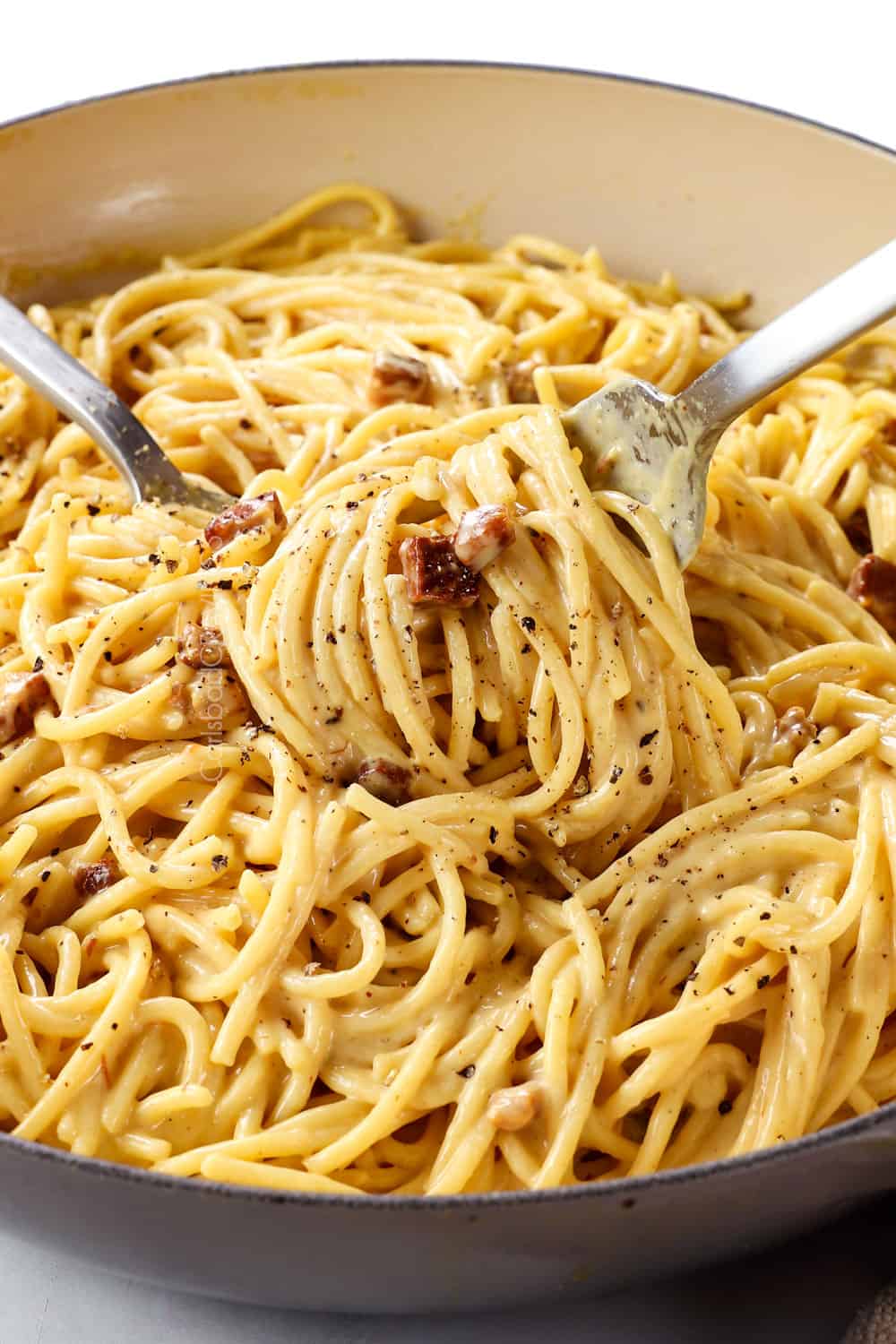
FOR COOKING THE PORK
- Remove the guanciale/pancetta/bacon from the fridge. Transfer the bacon from the fridge to your counter 15 to 20 minutes before cooking. At room temperature pork cooks up more quickly and evenly (just like steak).
- Don’t cook guanciale at too high of heat. The pork should be cooked over medium heat, or medium-low if your skillet runs hot, until the fat is rendered and then you may turn it up to medium to finish crisping up. If you cook it at too high of heat, you’ll end up with the chewy pork and the seemingly oxymoron of slightly burnt pork that’s also slightly under-cooked because the fat is not adequately rendered.
- Don’t burn the pork! If you burn the pork, your entire dish will be ruined because the burnt drippings will permeate throughout the pasta and that is all you will taste.
- Scrape up the golden bits. After you cook the pork, there will be golden bits on the bottom of the pan – these are flavor gold! Make sure to scrape up the bits while you toss the pasta in the drippings.
FOR MAKING THE CARBONARA SAUCE
- Temper the eggs quickly. Don’t dilly dally between adding the cooked spaghetti to the pork drippings, tempering the eggs, and adding the egg mixture to the spaghetti. We want the spaghetti hot enough so its residual heat will cook the egg/cheese mixture.
- Don’t add the egg/cheese mixture all at once. Slowly add the mixture a little while turning the pasta. This will help the skillet retain its temperature so cheese melts more evenly.
- Thin sauce if needed. The consistency of the sauce should be like heavy cream. If it’s too thick, then slowly stir in some reserved pasta water one tablespoon at a time until it reaches desired consistency while tossing constantly.
- Thicken the sauce if needed. If your sauce is runny then it simply needs more time to cook and thicken. If it’s extra watery and not coming together, then you can turn the heat to low or even medium-low but don’t stop tossing or your sauce can scramble!
- Adjust to taste. Make sure to taste the pasta first before adding any salt or pepper to taste.
PASTA CARBONARA RECIPE VARIATIONS
This Carbonara recipe is an excellent springboard for all sorts of variations – just don’t call it Carbonara! Here are just a few ideas:
- Add cream: Add some heavy cream for an extra indulgent sauce.
- Swap cheese: Mix up the flavor profile by using Parmesan in place of Pecorino Romano or a combination. Parmesan is not as strong, so adjust your flavor expectations. You can also add in different melting cheeses such as mozzarella, Gouda, Monterrey, smoked cheddar, Muenster, Fontina or Colby Jack, Gruyere, etc.
- Add protein: In addition to the guanciale/pancetta/bacon, or in place of it, try andouille sausage, shrimp, chicken or pork.
- Add veggies: Add any chopped vegetables such as bell peppers, asparagus, broccoli, zucchini, green beans, peas etc. Sauté in the drippings after you remove the guanciale. If using frozen peas, thaw and stir in with the egg/cheese mixture to warm through.
- Add mushrooms: Pan fry sliced baby Bella mushrooms, remove from the skillet then add back to the sauce at the end of cooking. Check out my mushroom chicken recipe to see exactly how I caramelize my mushrooms.
- Add cherry tomatoes and/or sun-dried tomatoes: Rinse about ½ cup sun-dried tomatoes, pat dry, chop and sauté in the drippings.
- More add-ins: Try adding roasted bell peppers, artichokes, olives, capers, etc.
- Spice it up: Toss in ¼-½ teaspoon red pepper flakes for a kick.
- Make it gluten free: Use gluten-free pasta such as Tinkyada brand. I don’t think other gluten free options such as sweet potato noodles, zoodles or spaghetti squash will work because the pasta needs to be piping hot to cook the sauce.
- Make it vegetarian: Omit the bacon or use a vegan bacon alternative. You will need to use butter or oil (or a combo) in place of the bacon grease.
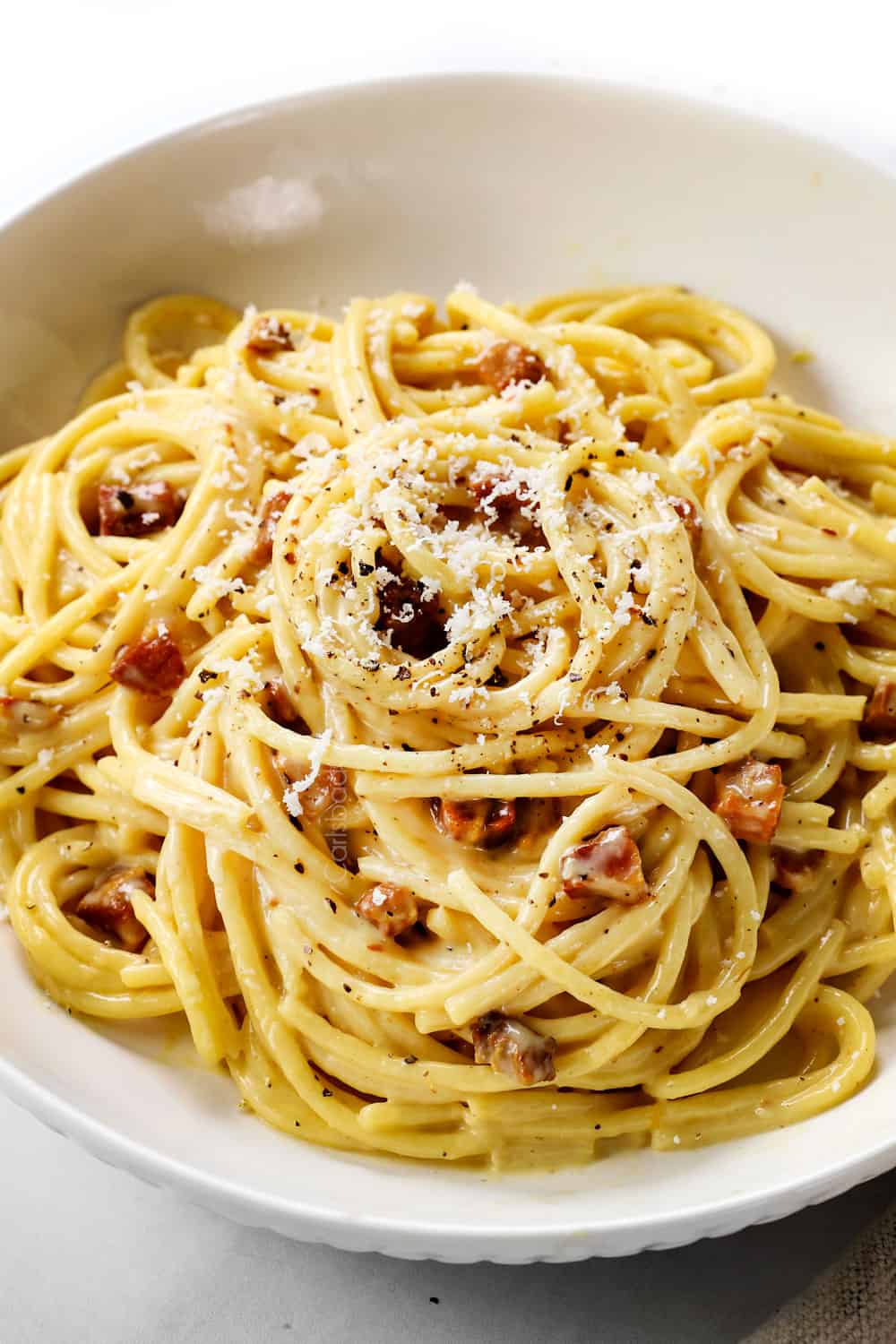
CAN YOU PREP CARBONARA RECIPE AHEAD?
You can prep parts of this Spaghetti Carbonara recipe in advance so the final dish comes together quickly
- Cook pork (and make sure to save the grease!): The guanciale can be cooked ahead of time and stored for up to 4 to 5 days in the refrigerator. The only problem is, it won’t be as crispy. You can try crisping it up by sizzling it in some of the reserved drippings when ready to serve.
- Grate cheese: Prep and store the cheese an airtight container in the refrigerator for up to one week.
- Mix egg mixture: Mix the eggs and cheese together, cover and store in an airtight container for up to 3 days. Bring to room temperature before adding the starchy pasta water.
HOW TO STORE AND REHEAT spaghetti CARBONARA
- Store in an airtight container in the refrigerator for 4-5 five days.
- Transfer portions to a microwave-safe dish, microwave for 1 minute, stir, then continue to heat at 30-second intervals until warmed through.
- Transfer to a skillet and heat over medium heat, stirring often. You may want to add a splash of milk or heavy cream if the pasta seems dry.
CAN I FREEZE CARBONARA RECIPE?
I do not recommend freezing Spaghetti Alla Carbonara. You will find the spaghetti can turn mushy; and the egg-based sauce will become a funky texture.
WHAT TO SERVE WITH SPAGHETTI CARBONARA?
Enjoy this Spaghetti Carbonara with a simple green salad or any one of the following sides:
- Salad: This easy pasta recipe is wonderfully creamy, smoky and salty so it pairs nicely with a fresh salad such as Caesar Salad, Strawberry Spinach Salad, Wedge Salad with Blue Cheese Ranch, , Apple Salad, Fall Salad or Italian Green Bean Salad.
- Veggies: This Carbonara Pasta pairs well with roasted or sautéed veggies such as Roasted Parmesan Broccoli, Roasted Parmesan Asparagus or Sautéed Brussels Sprouts with Garlic, Lemon, Butter.
- Fruit: Go simple with grapes or melon or we love Fruit Salad with Honey Lime Vinaigrette in the summer or Winter Fruit Salad with Honey Lime Poppy Seed Vinaigrette in the fall/winter.
- Bread: The Carbonara Sauce is begging for bread to mop up the delectable sauce! Try it with Garlic Bread, Garlic Parmesan Butter Breadsticks or Soft and Fluffy Dinner Rolls.
COMMONLY ASKED QUESTIONS
Carbonara is traditionally made with long, thin pasta such as spaghetti, swaddled in a glossy, silky emulsified egg-cheese sauce that’s about the consistency of heavy cream. The cheese and highlights of crispy pork (guanciale, pancetta or thick-cut bacon) infuse the pasta with a salty, earthy, richness laced with freshly cracked pepper.
No, you do not have to worry about your Spaghetti Carbonara tasting like eggs! Although the sauce contains eggs, it also boasts an almost ridiculous amount of sharp, salty, tangy, and pungent Pecorino Romano cheese and rich, salty, savory pork. These two ingredients overshadow any taste of eggs!
The eggs in Pasta Carbonara do not stay completely raw as they cook into creamy silkiness while tossed with the hot pasta but they do not reach the food safe temperature of 160 degrees F, or else they would turn into scrambled eggs. Therefore, if Carbonara is going to be consumed by anyone with a compromised immune system, are pregnant or elderly, I suggest using pasteurized eggs due to the risk of salmonella.
If the Carbonara is going to be consumed by anyone with a compromised immune system, are pregnant or elderly, I suggest using pasteurized eggs due to the risk of salmonella. Pasteurized eggs are just a little more expensive but pasteurization destroys any potential bacteria and viruses so they are completely safe to eat raw. The FDA says: “For recipes that call for eggs that are raw or undercooked when the dish is served — like Caesar salad dressing and homemade ice cream — use either shell eggs that have been treated to destroy Salmonella, by pasteurization or another approved method, or pasteurized egg products.”
This recipe uses Pecorino Romano cheese because it is quintessential to authentic Carbonara and far more flavorful than Parmesan. While there are different cheeses that you can use in this sauce, including Parmesan cheese, none of them will give you the same authentic and flavorful result.
While both Alfredo and Carbonara are white creamy sauces with cheese, the similarities stop there. Alfredo sauce is made with generous amounts of butter, heavy cream and Parmesan. Carbonara is made with eggs, starchy pasta water and Pecorino Romano. Pasta Carbonara is also distinguished by salty, savory, crispy pieces of pork (guanciale, or easier to find pancetta or thick-cut bacon), that permeate the whole dish.
No. Authentic Carbonara sauce is a light creamy sauce that’s traditionally made from eggs and Pecorino Romano cheese without any heavy cream or butter. It becomes creamy as the starchy pasta water, eggs and cheese emulsify together while being tossed with the hot pasta.
Carbonara is a creamy white sauce that’s traditionally made from eggs, Pecorino Romano cheese, and cured pork that’s called guanciale.
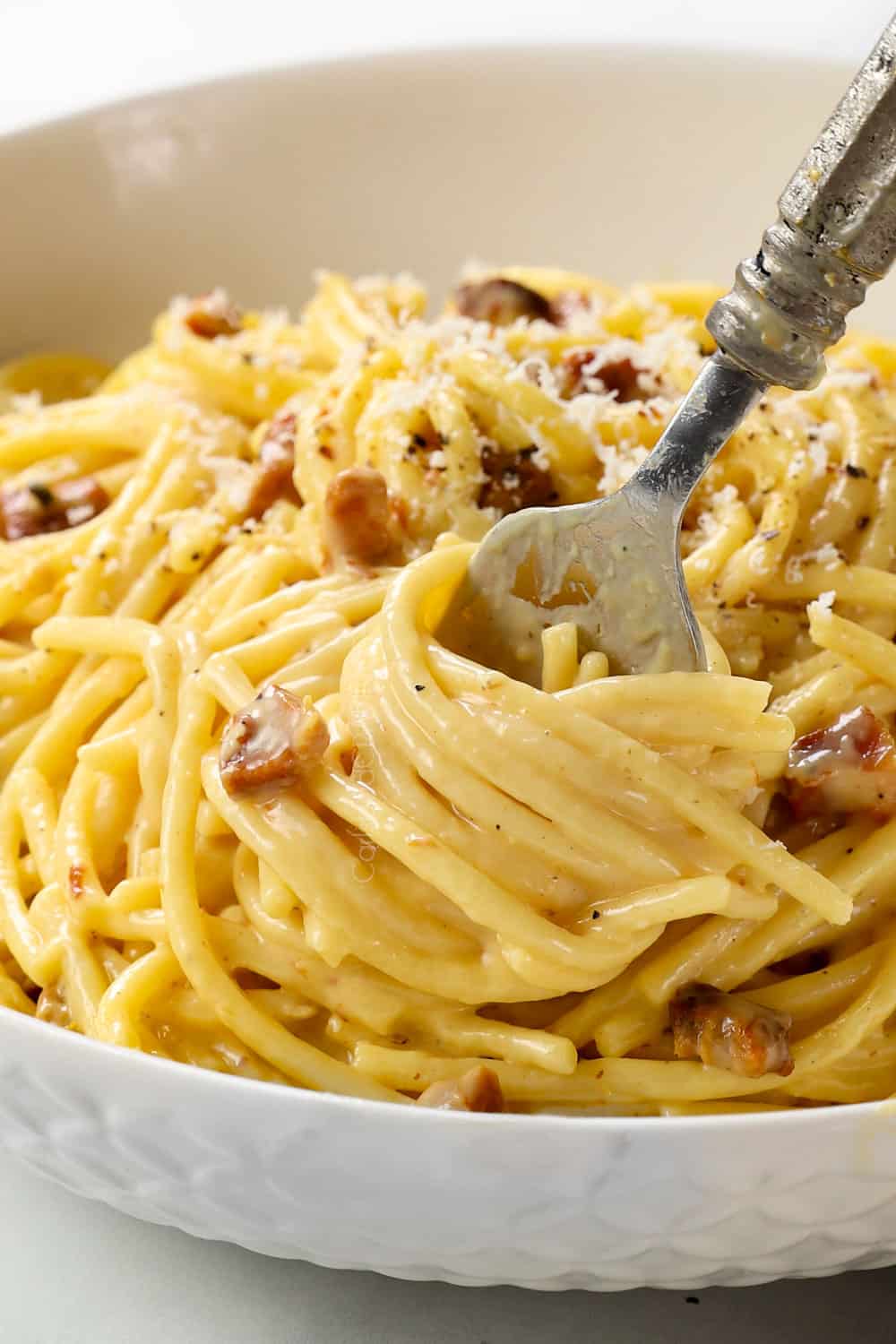
WANT TO TRY THIS best carbonara RECIPE?
PIN IT TO YOUR pasta, italian or 30 minute meals BOARD TO SAVE FOR LATER!
FIND ME ON PINTEREST FOR MORE GREAT RECIPES! I AM ALWAYS PINNING :)!
©Carlsbad Cravings by CarlsbadCravings.com
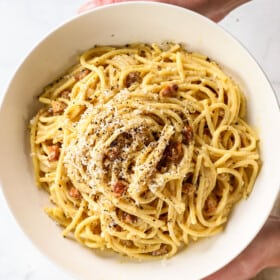
Pasta Carbonara
Save This Recipe To Your Recipe Box
You can now create an account on our site and save your favorite recipes all in one place!
Ingredients
- 4 egg yolks at room temperature
- 2 whole eggs at room temperature
- freshly cracked pepper
- 3 ounces finely, freshly grated Pecorino Romano, NOT Parmesan
- 1 pound spaghetti
- 2 teaspoons salt
- 7 ounces diced guanciale (or pancetta or thick-cut bacon)
Instructions
- Egg mixture: In a liquid measuring cup or medium mixing bowl, whisk together the eggs, egg yolks, grated cheese, and plenty of freshly-cracked pepper (about 50 turns); set aside.
- Cook pork: Cook the diced pork in a large sauté pan over medium heat until browned and crispy, about 7-10 minutes (use a pan large enough to eventually hold all of the pasta, preferable non-stick or enameled like this one). Remove the pan from the heat. Use a slotted spoon to transfer the pork to a paper towel lined plate. Don’t clean out the pan – we want the grease for later! If there are more drippings than you feel comfortable with, you can drain some; set aside. Meanwhile, cook the pasta:
- Cook the pasta: Add 2 quarts water (8 cups) to a large Dutch oven (or stockpot wide enough to fit spaghetti). The water will be very shallow because we want it to be very starchy. Cover and bring to a boil. Uncover and stir in 2 teaspoons salt then add spaghetti. Cook pasta uncovered until 1 minute shy of al dente, stirring often so the spaghetti doesn’t stick. Using tongs, transfer the spaghetti to the pork drippings; set aside. Reserve starchy pasta water.
- Temper the eggs: While vigorously whisking the egg mixture with one hand, slowly drizzle 1 cup starchy hot water into the egg mixture a couple tablespoons at a time until incorporated (DON’T STOP WHISKING or the eggs will scramble!). Set aside.
- Toss the pasta: Place the pasta over medium heat while tossing with ½ cup starchy pasta water until al dente, about 1 minute, then turn off the heat.
- Combine: While continuously tossing the spaghetti, SLOWLY drizzle the egg mixture into the pasta. Continue tossing constantly until the cheese melts and the eggs thicken to form a glossy sauce. Thin sauce with additional pasta water if needed. Add the pork and toss to combine. Immediately transfer to a serving bowl (so the eggs don't continue to cook). Season to taste with freshly cracked salt, pepper and red pepper flakes if desired. Serve immediately.
Video
Notes
What pork should I use?
- Guanciale: is the authentic meat of choice for Carbonara. It is an Italian cured pork cheek that’s especially fatty, salty, and flavorful (because it’s cured with additional seasonings), melting down perfectly to form delicious oils for the Carbonara Sauce. However, guanciale can be difficult to find in US, so you may substitute with thick-cut bacon or diced pancetta.
- Pancetta: will have a cleaner pork flavor than bacon because it is salt-cured, but it doesn’t stay as crispy and can become chewy quickly once combined with the pasta. If you go with pancetta, try to avoid the wafer-thin stuff. Instead, look for pancetta that you can cut into thick chunks yourself or sometimes you can find pancetta in containers in the meat or deli section that are diced for you.
- Bacon: American bacon is smoked so it will have a pleasantly sweet-smoky flavor and manages to retain its crispy texture. Make sure to use thick-cut bacon to mimic the texture of guanciale and so it stays crispier for longer.
Tips and Tricks
- Pecorino Romano VS Parmesan. Quality, aged Pecorino Romano is quintessential to authentic Carbonara – NOT Parmesan. Pecorino Romano is three times more flavorful (sharper, saltier, tangier, more pungent) than Parmesan and results in superior flavor and silkiness – AKA far superior pasta. If you must use Parmesan, be aware it will not taste as intoxicating as intended – next time splurge for the authentic cheese!
- Use finely grated cheese. Grate your cheese on the finest holes of your cheese grater, the small, prickly side of the box grater to produce powdery Pecorino Romano.
- Don’t overcook the sauce: You’ll know the Carbonara Sauce is ready when it thickens, tightens, and clings to the spaghetti, leaving a clear trail as you stir. Don’t continue to cook after this point because the eggs can scramble.
- Don’t burn the pork! If you burn the pork, your entire dish will be ruined because the burnt drippings will permeate throughout the pasta and that is all you will taste.
- Temper the eggs quickly. Don’t dilly dally between adding the cooked spaghetti to the pork drippings, tempering the eggs, and adding the egg mixture to the spaghetti. We want the spaghetti hot enough so its residual heat will cook the egg/cheese mixture.
- Thicken the sauce if needed. If your sauce is runny then it simply needs more time to cook and thicken. If it’s extra watery and not coming together, then you can turn the heat to low or even medium-low but don’t stop tossing or your sauce can scramble!
HOW TO STORE AND REHEAT
- To store: Store in an airtight container in the refrigerator for 4-5 five days.
- To freeze: I do not recommend freezing Carbonara because the egg-based sauce will become a funky texture.
- To reheat in the microwave: Transfer portions to a microwave-safe dish, microwave for 1 minute, stir, then continue to heat at 30-second intervals until warmed through.
- To reheat on the stovetop: Transfer to a skillet and heat over medium heat, stirring often. You may want to add a splash of milk or heavy cream if the pasta seems dry.

Did You Make This Recipe?
Tag @CarlsbadCravings and Use #CarlsbadCravngs
Leave a Review, I Always Love Hearing From You!
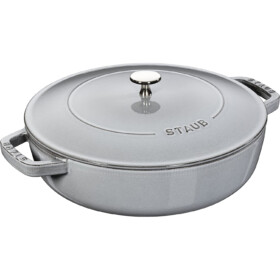
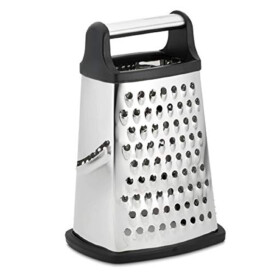
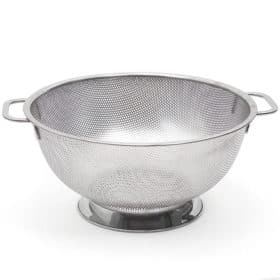
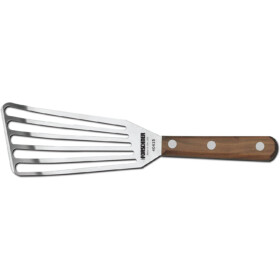
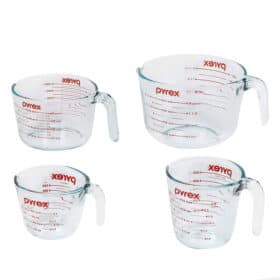
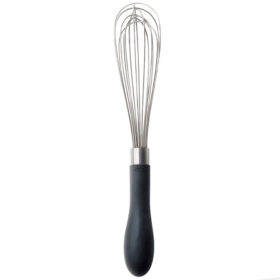
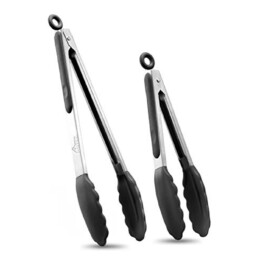
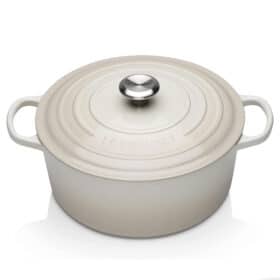
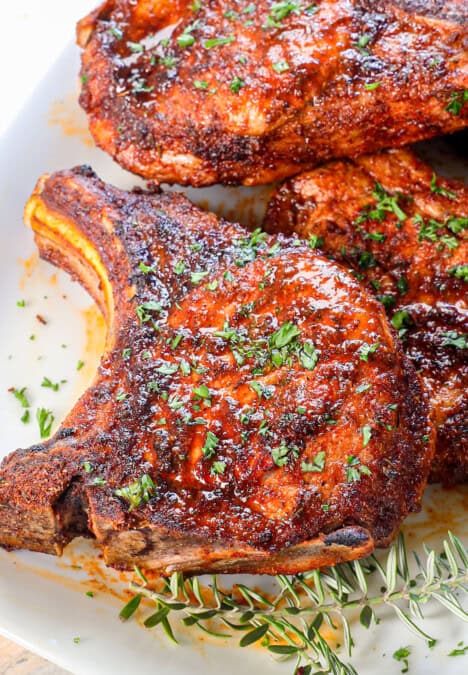
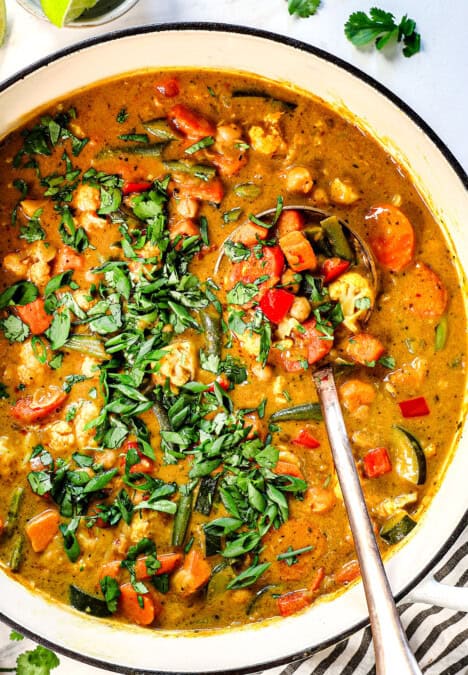
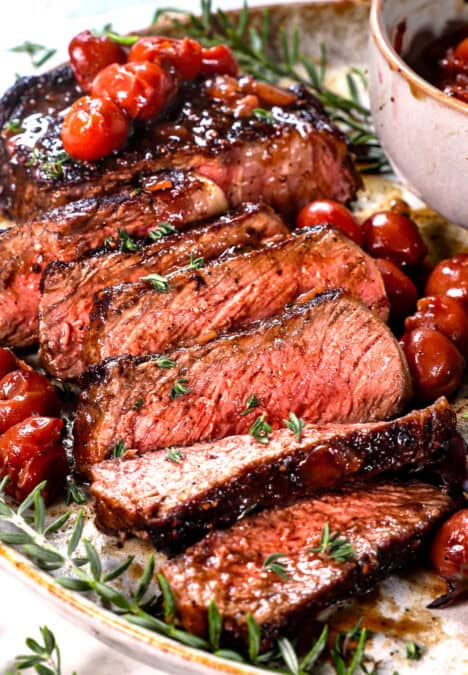
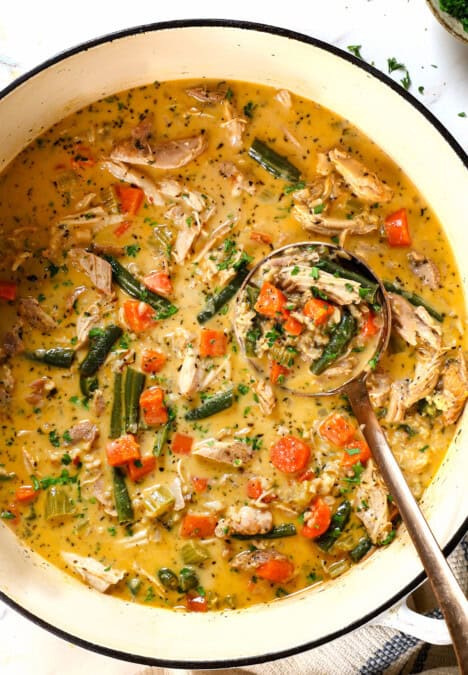
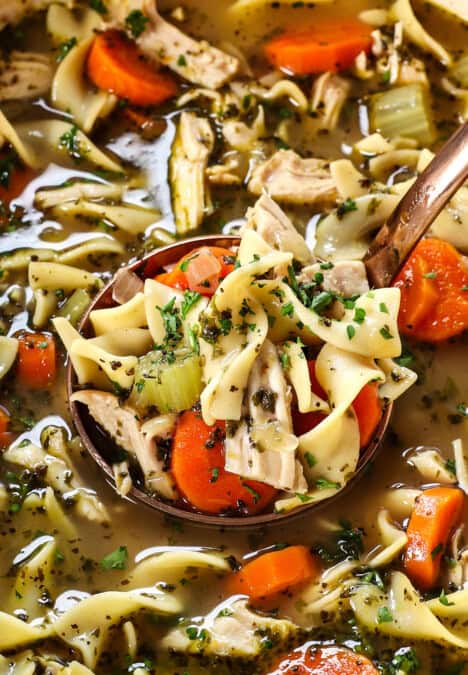
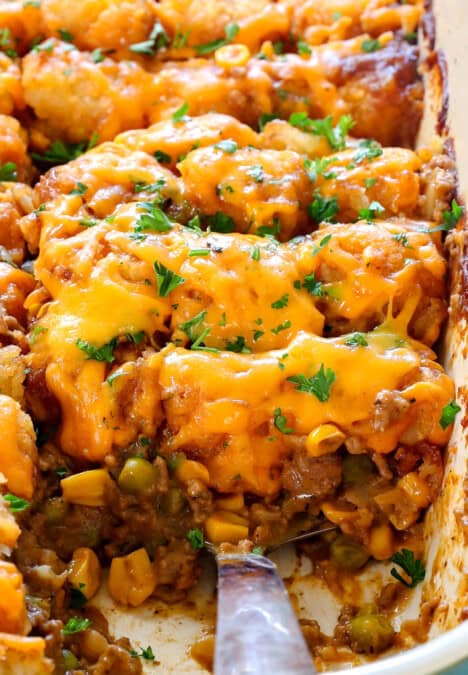

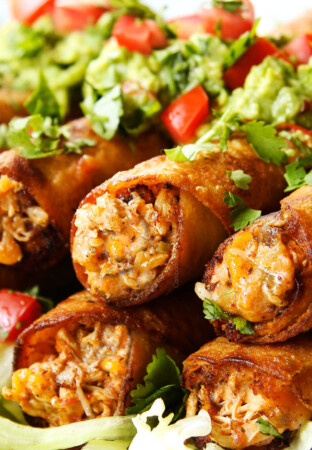
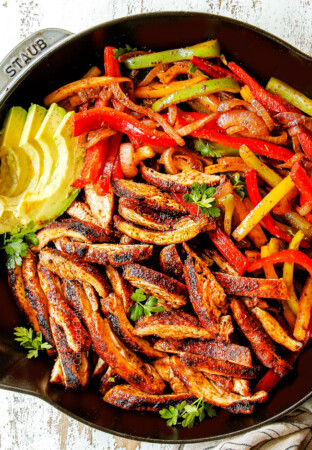
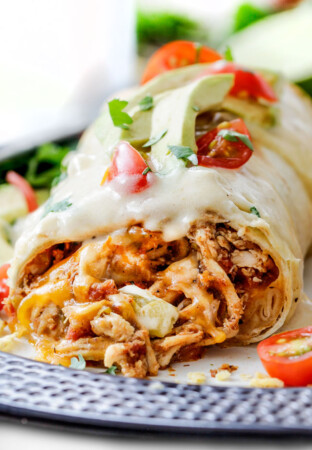
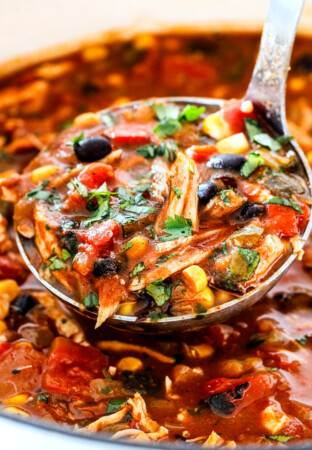
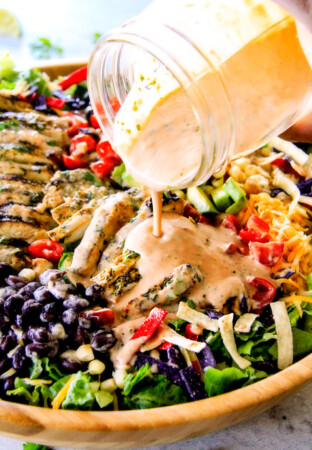
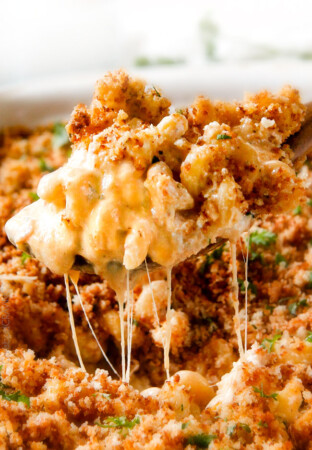
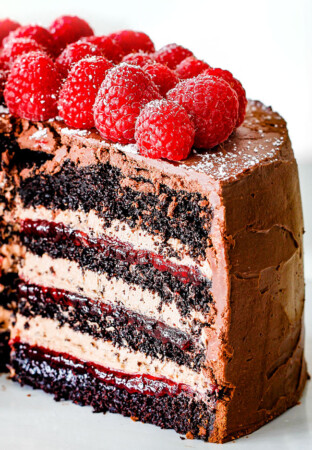

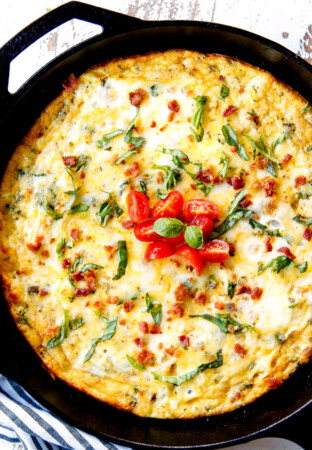
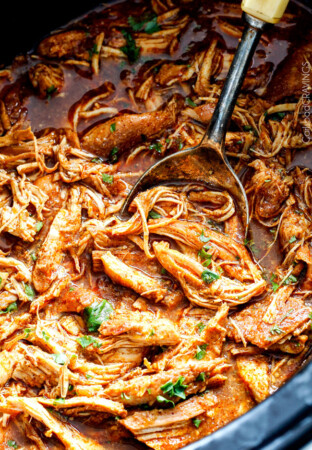
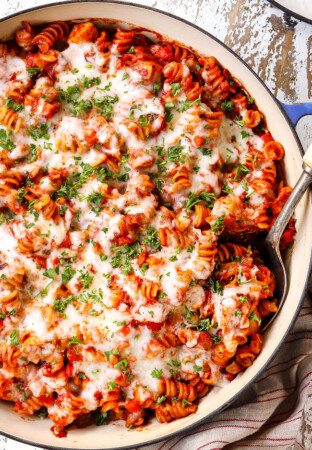

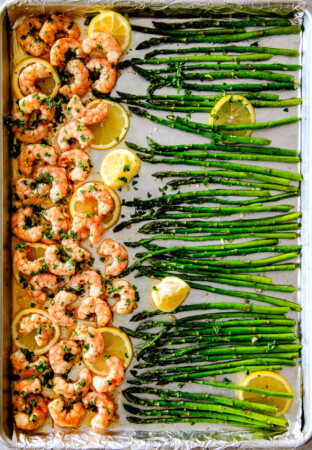
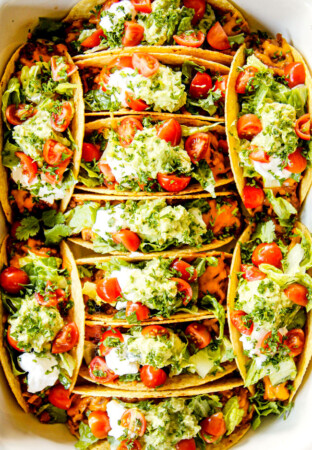
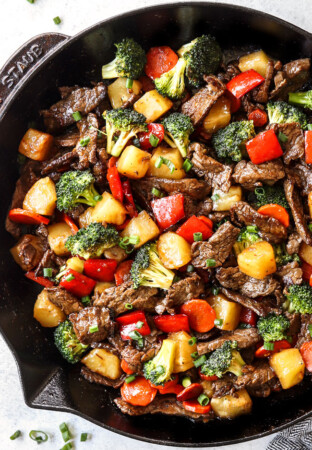
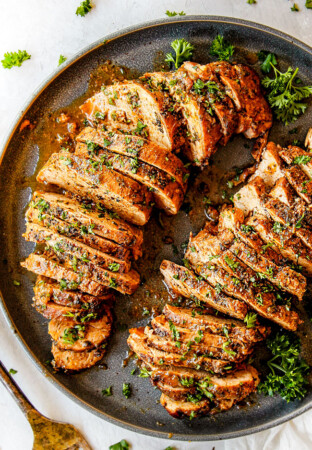
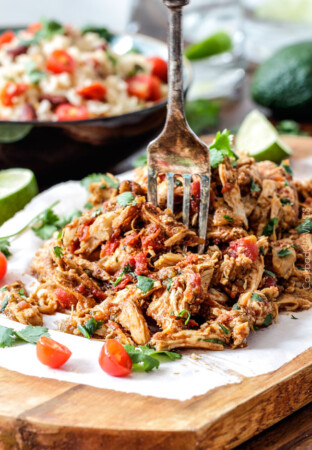
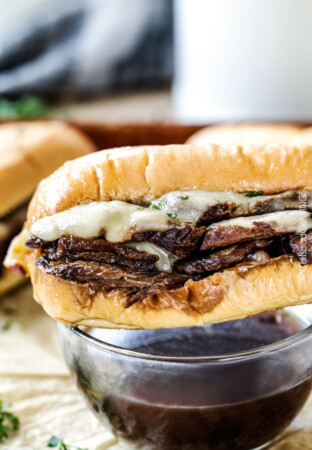
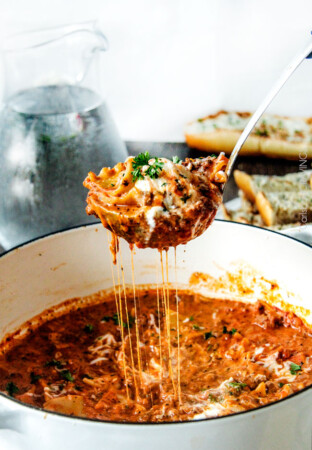
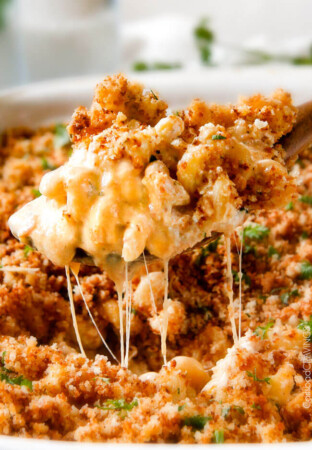
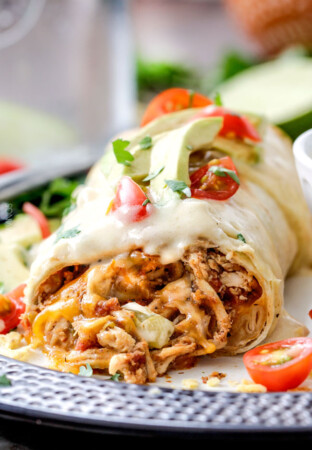
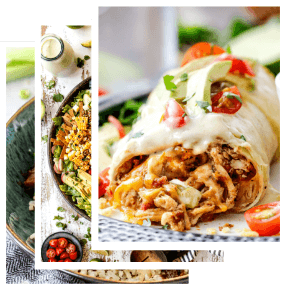
Erica says
I’ve been eying this recipe for a few months. I finally got around to making it for dinner today and the whole family loved it. It’s easy to make. The only part that was time consuming was grating the cheese. But I made my teen take over while I did other things so it wasn’t too bad, haha.
Jen says
Love the idea of putting your teen to work! I’m so pleased you found this recipe easy and delicious, thanks Erica!
Cara says
I have made this before and it is delicious. I have duck eggs from a friend and am wondering if they would be just as good? Should I do a mix of chicken and duck eggs?
Jen says
I think they would work great! A duck egg is equivalent to one and a half or two chicken eggs, so just keep that in mind when adjusting the recipe!
Teresa says
Just as described. Easy, Creamy flavorful pasta. Next time mushrooms. Thanks for a well described and thorough recipe.
Jen says
You are so welcome, Teresa! I am so happy you enjoyed this pasta! Thank you so much for your review!
Deb says
I’m married to an Italian who grew up eating this dish regularly, but for some reason, we don’t have it very often now, even though we both love it. I always make sure to get it when we go to an Italian restaurant but have always been intimidated to make it at home, even with his mom’s handwritten recipe. Happily, now that I’ve read all of your, as always, detailed tips and tricks, and watched the video, I finally feel ready to give it a try. My mouth is watering just looking at your delectable pics. I never leave your site without wanting to make EVERYTHING! I appreciate how you make complicated recipes seem doable, and I can’t wait to try this one very soon! *adding ingredients to shopping list*
Jen says
Yay! Thank you so much, Deb, your comment made my day! I am so happy you are giving this recipe a try, and I am excited to hear how it turns out! 🙂
Wendi says
We all loved this! I added shrimp at the end and it was great. The directions are very clear and easy to follow.
Jen says
I’m so glad that you found it easy and delicious!